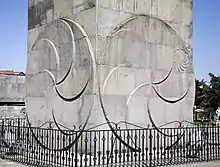Symbole arménien de l'éternité
Le symbole arménien de l'éternité est l'un des symboles nationaux de l'Arménie[1]. C'est un élément courant et facilement observable de l'architecture arménienne[2] - [3], fréquemment présent sur les khatchkars ou sur les murs des églises.
Ce symbole est appelé Arevakhach (en arménien : Արևախաչ)[4] signifiant plus ou moins littéralement « Croix-soleil ».
Évolution et usage
Dans la culture médiévale arménienne, ce signe symbolise la vie éternelle[5]. On peut l'observer sur les stèles arméniennes dès le Ve siècle puis sur les khatchkars[6]. Au VIIIe siècle, l'utilisation de ce symbole est très ancrée dans l'iconographie nationale[7]. Cette utilisation se confirme d'ailleurs jusqu'à l'époque contemporaine[8]. Outre sur les khatchkars, ce symbole se trouve sur les murs d'églises, sur les pierres tombales ou dans les manuscrits arméniens.
Codage du caractère
Dans le standard ArmSCII (en) (Armenian Standard Code for Information Interchange), le symbole arménien de l'éternité a été codé sur sept puis huit bits depuis au moins 1987. En 2010, ArmSCII a fait une proposition d'intégration du symbole arménien de l'éternité auprès du consortium Unicode[9].
Références
- [PDF](en) « Armenian Eternity Sign », sur sarm.am.
- (en) Jacob G. Ghazarian, The Mediterranean legacy in early Celtic Christianity : a journey from Armenia to Ireland, Bennett & Bloom, , 263 p. (lire en ligne), p. 171
« Quite a different version of the Celtic triskelion, and perhaps the most common pre-Christian symbolism found throughout Armenian cultural tradition, is the round clockwise (occasionally counter-clockwise) whirling sun-like spiral fixed at a centre — the Armenian symbol of eternity. »
. - (en) K. B. Mehr et M. Markow, Mormon Missionaries enter Eastern Europe, Brigham Young University Press, , 252 p., p. 399
« She viewed a tall building with spires and circular windows along the top of the walls. It was engraved with sun stones, a typical symbol of eternity in ancient Armenian architecture. »
. - (hy) « Հայկական արիական հիմնական նշանների (սիմվոլների) խորհուրդը եւ չափային շղթաները », sur hayary.org (consulté le ).
- (en) Elisabeth Bauer-Manndorff, Armenia : Past and Present, Reich Verlag, , p. 89
« The circle, as a line returning upon itself, represented perfection. Having neither beginning, nor end, it was the symbol of eternity. The architects expressed the concept of everlasting, celestial life in the knowledge of the presence and effect of the divine power by sphere. »
. - (en) N. Sahakyan, Armenian Highland, RAU Press, , 349 p., p. 150.
- (en) Jacob G. Ghazarian, The Mediterranean legacy in early Celtic Christianity : a journey from Armenia to Ireland, Bennett & Bloom, , 263 p., p. 186
« The eighth, or ninth, century date of this two examples of Irish stone crosses places them chronologically well after the carving of stone crosses in Armenia and the use of the Armenian symbol of eternity had become a long established national iconographical practice. »
. - (hy) A. K. Zarian, « Խաչքարերի խորհրդանշաններին և միթրայականությանը վերաբերող պատկերագրական հարցեր », Patma-Banasirakan Handes, , p. 202-219 (ISSN 0135-0536, lire en ligne).
- [PDF](en) « Armenian Eternity Sign », Consortium Unicode, , p. 10–12.





